KIA Optima 2010 3.G Owner's Manual
Manufacturer: KIA, Model Year: 2010, Model line: Optima, Model: KIA Optima 2010 3.GPages: 336, PDF Size: 6.46 MB
Page 311 of 336

Maintenance
46
7
G210201AMG
Main fuse
If the main fuse is blown, it must be
removed as follows:
1. Remove the fuse panel cover on the
right side in the engine compartment.
2. Remove the nuts shown in the picture above.
3. Replace the fuse with a new one of the same rating.
4. Reinstall in the reverse order of removal.
✽ ✽NOTICE
If the main fuse is blown, consult an
authorized KIA dealer.CAUTION
After checking the fuse panel in the
engine compartment, securelyinstall the fuse panel cover. If not,electrical failures may occur fromwater contact.
OMG065019
Page 312 of 336

747
Maintenance
✽
✽NOTICE
Not all fuse panel descriptions in this
manual may be applicable to your vehi-
cle. It is accurate at the time of printing.
When you inspect the fuse panel in your
vehicle, refer to the fuse panel label.
G210300AMG-EU
Fuse/relay panel description
Inside the fuse/relay panel covers, you can find the fuse/relay label describing fuse/relay name and capacity.
Engine compartment
OMG065007/OMG065006
Driver’s side panel
Page 313 of 336
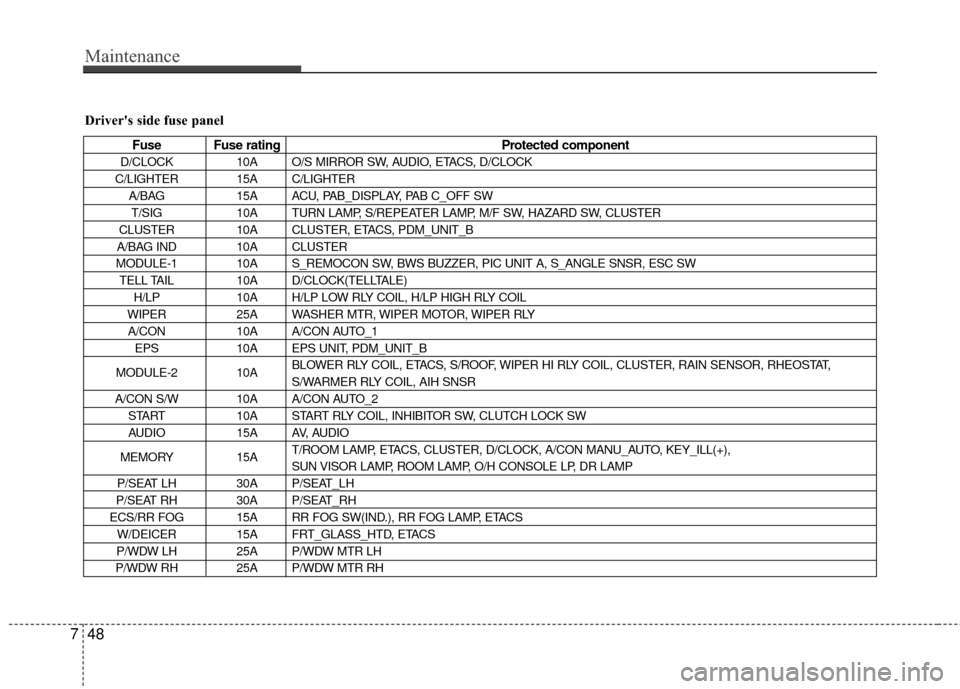
Maintenance
48
7
Driver's side fuse panel
Fuse Fuse rating Protected component
D/CLOCK10A O/S MIRROR SW, AUDIO, ETACS, D/CLOCK
C/LIGHTER 15A C/LIGHTER A/BAG 15A ACU, PAB_DISPLAY, PAB C_OFF SW
T/SIG 10A TURN LAMP, S/REPEATER LAMP, M/F SW, HAZARD SW, CLUSTER
CLUSTER 10A CLUSTER, ETACS, PDM_UNIT_B
A/BAG IND 10A CLUSTER
MODULE-1 10A S_REMOCON SW, BWS BUZZER, PIC UNIT A, S_ANGLE SNSR, ESC SW TELL TAIL 10A D/CLOCK(TELLTALE)
H/LP 10A H/LP LOW RLY COIL, H/LP HIGH RLY COIL
WIPER 25A WASHER MTR, WIPER MOTOR, WIPER RLY
A/CON 10A A/CON AUTO_1
EPS 10A EPS UNIT, PDM_UNIT_B
MODULE-2 10A BLOWER RLY COIL, ETACS, S/ROOF, WIPER HI RLY COIL, CLUSTER, RAIN SENSOR, RHEOSTAT,
S/WARMER RLY COIL, AIH SNSR
A/CON S/W 10A A/CON AUTO_2 START 10A START RLY COIL, INHIBITOR SW, CLUTCH LOCK SW
AUDIO 15A AV, AUDIO
MEMORY 15AT/ROOM LAMP, ETACS, CLUSTER, D/CLOCK, A/CON MANU_AUTO, KEY_ILL(+),
SUN VISOR LAMP, ROOM LAMP, O/H CONSOLE LP, DR LAMP
P/SEAT LH 30A P/SEAT_LH
P/SEAT RH 30A P/SEAT_RH
ECS/RR FOG 15A RR FOG SW(IND.), RR FOG LAMP, ETACS W/DEICER 15A FRT_GLASS_HTD, ETACS
P/WDW LH 25A P/WDW MTR LH
P/WDW RH 25A P/WDW MTR RH
Page 314 of 336

749
Maintenance
Fuse Fuse ratingProtected component
SAFETY PWR 20A SAFETY WDW
MIRR HTD 10A RR MIRROR HTD
T/LID OPEN 15A F/FILLER ACTR, LATCH_T_LID, ETACS ADJ PEDAL 10A KEY SOL, ATM SOL, ADJ PEDAL SW, ADJ PEDAL MTR, ATM&K/LOCK CTRL UNIT STOP LP 15A STOP LAMP, HIGH MOUNTED STOP LAMPHAZARD 15A TURN LAMP, S/REPEATER LAMP, CLUSTER, ETACS, OBDII
TPMS (if equipped) 10A DR WARN PIC SW, PIC UNIT_A, FOB_HOLDER_EXTN
DR LOCK 25A D/LOCK MOTOR, T/TURN UNLOCK MTR, ETACSTAIL LH 10A FRT FOG RLY COIL, COMBI LP_LH, LICENSE LAMP_LH, POS.LP LH
TAIL RH 10A POS.LP RH, GLOVE BOX LP, COMBI LP_RH, LICENSE LAMP_RH, RR.FOG SW,
P/WINDOW SW, ESP SW, HAZARD SW, A/CON SW, SEAT WARMER SW, A.CON SW,
S_REMOCON_SW, SPORT_MODE_SW
BLOWER MTR 10A BLOWER_MTR SPARE 10A -PDM-1 10A PDM_UNIT_B, SSB
PDM-2 20A PDM_UNIT_A
Page 315 of 336

Maintenance
50
7
Engine compartment
Description Fuse rating Protected component
ALT150A(2.7L)
FUSIBLE LINK, FUSE
125A(2.4L)
IGN1 30A
FUSE (A/BAG, TURN, CLUSTER, TELTAIL, A/BAG IND., 21, PCU, MODULE-1, SPARE)
IGN2 30A FUSE (MODULE-2, H/LP, A/CON, WIPER, SPARE, SATRT), BUTTON RELAY
TAIL 20A TAIL_LP_LH, TAIL_LP_RH
FUSIBLE RR HTD 40A MIRR HTD, RR_HTD_RELAY
LINK BLOWER 40A BLOWER MTR, FUSE (A/CON SW)
I/P B+1 30A FUSE (HAZARD, STOP LP, TPMS, T/LID, PEDAL ADJ, DR_LOCK)
I/P B+2 50AP/WINDOW RELAY, FUSE (RR FOG, P/SEAT_LH, P/SEAT_RH, W/DEICER,
POWER CONNECTOR, PDM_1, PDM_2)
ECU RLY 30A PCU, IGN COIL, INJECTOR, SENSOR
1 RAD FAN 40A(2.7L)
RAD FAN MTR
30A(2.4L)
2 ABS1 40A ABS/ESC UNIT
3 ABS2 40A ABS/ESC UNIT
4 A/CON 10A A/CON COMPRESSOR
5 S/WARMER 25A S/WARMER_LH, S/WARMER_RH
FUSE 6 P/AMP 20A P/AMP, AV-AMP
7 S/ROOF 20A S/ROOF MTR
8 P/OUTLET 25A P/OUTLET
9 FRT FOG 15A FRT FOG LAMP
10 HEAD LP HI 15A HEAD LP HI
11 HEAD LP LOW 15A HEAD LP LOW
12 HORN 15A HORN, B/ALARM HORN, HORN SW
Page 316 of 336

751
Maintenance
Description Fuse ratingProtected component
13 SNSR115A MAP, MAF, CMP, CCV, VIS, CPSV, ISCA, OCV, EGR, CAM, CKP, TDC SENSOR
14 SNSR2 15A O2 SENSOR, EGR ACTR
15 SNSR3 10A INJECTOR, PCU
16 IGN COIL 20A IGN COIL, PCU, O2 SENSOR
17 ECU-1 20A PCU
FUSE 18 F/PUMP 20A F/PUMP MTR
19 ECU 10A PCU
20 ATM 20A TCU, ATM_SOLENOID
21 BACK UP 10A BACK UP LAMP, ECM MIRROR, BWS UNIT
22 ABS 10A ABS/ESC UNIT
23 PCU 10A PCU, SPEED SENSOR
24 DRL 15A DRL CONTROL MODULE
Page 317 of 336
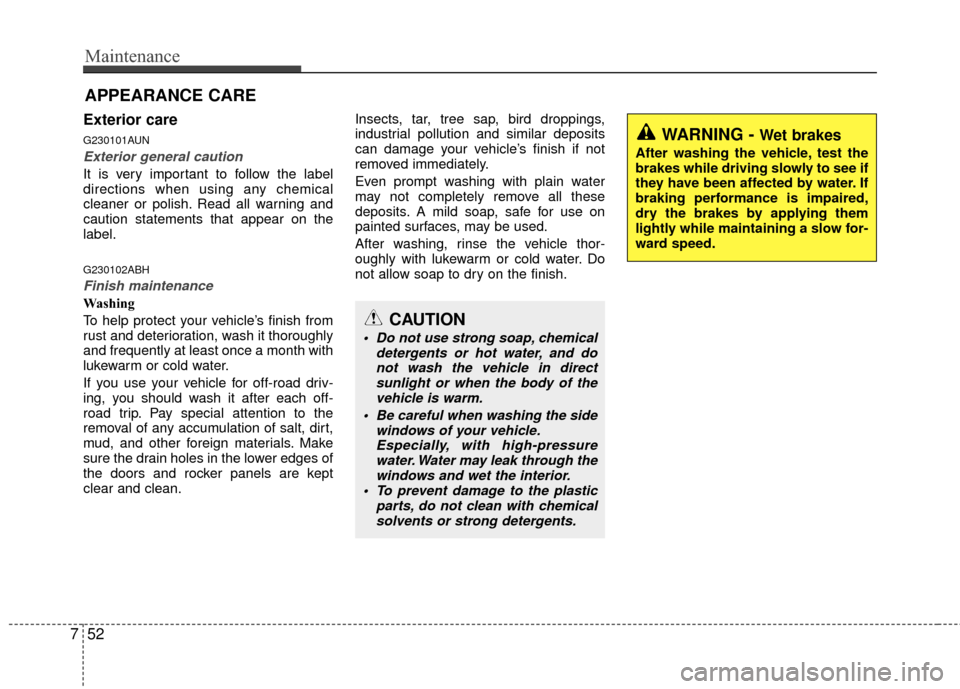
Maintenance
52
7
APPEARANCE CARE
Exterior care
G230101AUN
Exterior general caution
It is very important to follow the label
directions when using any chemical
cleaner or polish. Read all warning and
caution statements that appear on the
label.
G230102ABH
Finish maintenance
Washing
To help protect your vehicle’s finish from
rust and deterioration, wash it thoroughly
and frequently at least once a month with
lukewarm or cold water.
If you use your vehicle for off-road driv-
ing, you should wash it after each off-
road trip. Pay special attention to the
removal of any accumulation of salt, dirt,
mud, and other foreign materials. Make
sure the drain holes in the lower edges of
the doors and rocker panels are kept
clear and clean. Insects, tar, tree sap, bird droppings,
industrial pollution and similar deposits
can damage your vehicle’s finish if not
removed immediately.
Even prompt washing with plain water
may not completely remove all these
deposits. A mild soap, safe for use on
painted surfaces, may be used.
After washing, rinse the vehicle thor-
oughly with lukewarm or cold water. Do
not allow soap to dry on the finish.
WARNING - Wet brakes
After washing the vehicle, test the
brakes while driving slowly to see if
they have been affected by water. If
braking performance is impaired,
dry the brakes by applying them
lightly while maintaining a slow for-
ward speed.
CAUTION
Do not use strong soap, chemical
detergents or hot water, and donot wash the vehicle in directsunlight or when the body of the vehicle is warm.
Be careful when washing the side windows of your vehicle.Especially, with high-pressurewater. Water may leak through thewindows and wet the interior.
To prevent damage to the plastic parts, do not clean with chemicalsolvents or strong detergents.
Page 318 of 336
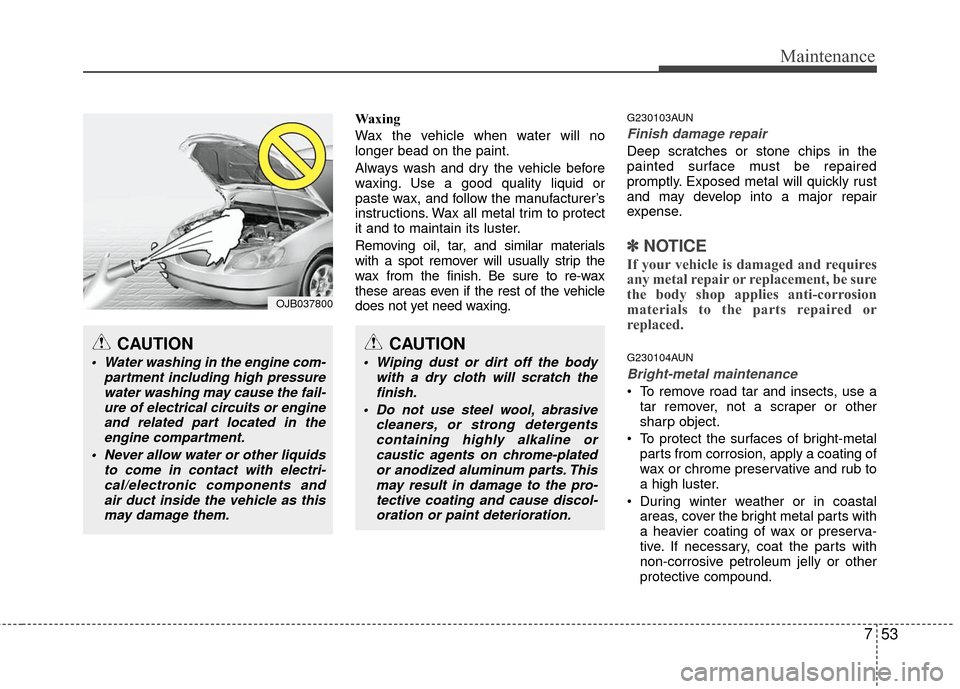
753
Maintenance
Waxing
Wax the vehicle when water will no
longer bead on the paint.
Always wash and dry the vehicle before
waxing. Use a good quality liquid or
paste wax, and follow the manufacturer’s
instructions. Wax all metal trim to protect
it and to maintain its luster.
Removing oil, tar, and similar materials
with a spot remover will usually strip the
wax from the finish. Be sure to re-wax
these areas even if the rest of the vehicle
does not yet need waxing.G230103AUN
Finish damage repair
Deep scratches or stone chips in the
painted surface must be repaired
promptly. Exposed metal will quickly rust
and may develop into a major repair
expense.
✽ ✽NOTICE
If your vehicle is damaged and requires
any metal repair or replacement, be sure
the body shop applies anti-corrosion
materials to the parts repaired or
replaced.
G230104AUN
Bright-metal maintenance
To remove road tar and insects, use a
tar remover, not a scraper or other
sharp object.
To protect the surfaces of bright-metal parts from corrosion, apply a coating of
wax or chrome preservative and rub to
a high luster.
During winter weather or in coastal areas, cover the bright metal parts with
a heavier coating of wax or preserva-
tive. If necessary, coat the parts with
non-corrosive petroleum jelly or other
protective compound.
CAUTION
Wiping dust or dirt off the body with a dry cloth will scratch thefinish.
Do not use steel wool, abrasive cleaners, or strong detergentscontaining highly alkaline orcaustic agents on chrome-platedor anodized aluminum parts. Thismay result in damage to the pro-tective coating and cause discol-oration or paint deterioration.
CAUTION
Water washing in the engine com- partment including high pressurewater washing may cause the fail-ure of electrical circuits or engineand related part located in theengine compartment.
Never allow water or other liquids to come in contact with electri-cal/electronic components andair duct inside the vehicle as thismay damage them.
OJB037800
Page 319 of 336
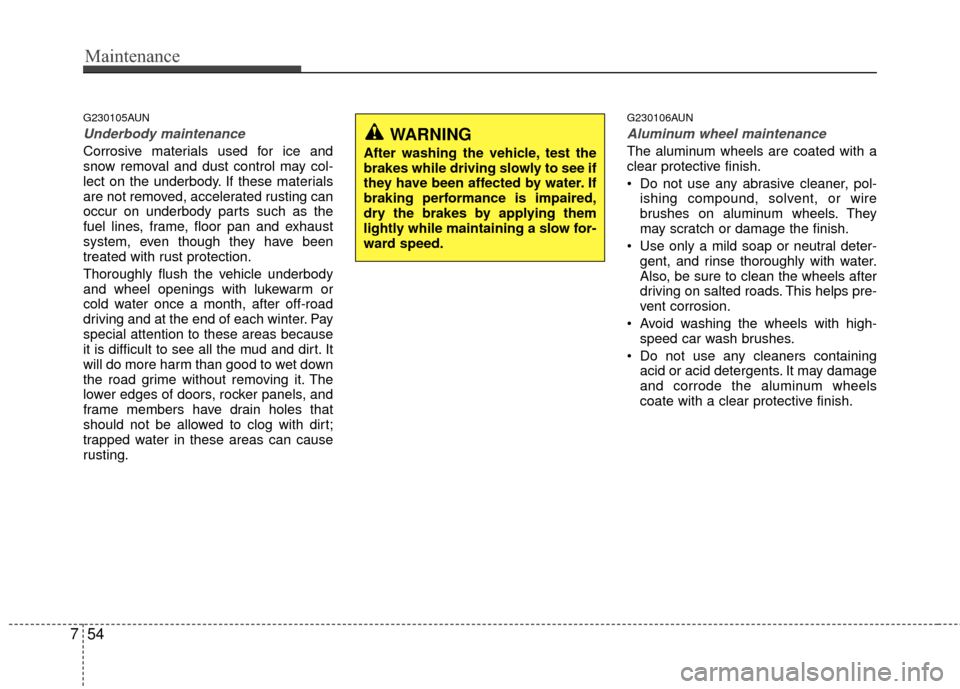
Maintenance
54
7
G230105AUN
Underbody maintenance
Corrosive materials used for ice and
snow removal and dust control may col-
lect on the underbody. If these materials
are not removed, accelerated rusting can
occur on underbody parts such as the
fuel lines, frame, floor pan and exhaust
system, even though they have been
treated with rust protection.
Thoroughly flush the vehicle underbody
and wheel openings with lukewarm or
cold water once a month, after off-road
driving and at the end of each winter. Pay
special attention to these areas because
it is difficult to see all the mud and dirt. It
will do more harm than good to wet down
the road grime without removing it. The
lower edges of doors, rocker panels, and
frame members have drain holes that
should not be allowed to clog with dirt;
trapped water in these areas can cause
rusting.
G230106AUN
Aluminum wheel maintenance
The aluminum wheels are coated with a
clear protective finish.
Do not use any abrasive cleaner, pol-
ishing compound, solvent, or wire
brushes on aluminum wheels. They
may scratch or damage the finish.
Use only a mild soap or neutral deter- gent, and rinse thoroughly with water.
Also, be sure to clean the wheels after
driving on salted roads. This helps pre-
vent corrosion.
Avoid washing the wheels with high- speed car wash brushes.
Do not use any cleaners containing acid or acid detergents. It may damage
and corrode the aluminum wheels
coate with a clear protective finish.
WARNING
After washing the vehicle, test the
brakes while driving slowly to see if
they have been affected by water. If
braking performance is impaired,
dry the brakes by applying them
lightly while maintaining a slow for-
ward speed.
Page 320 of 336
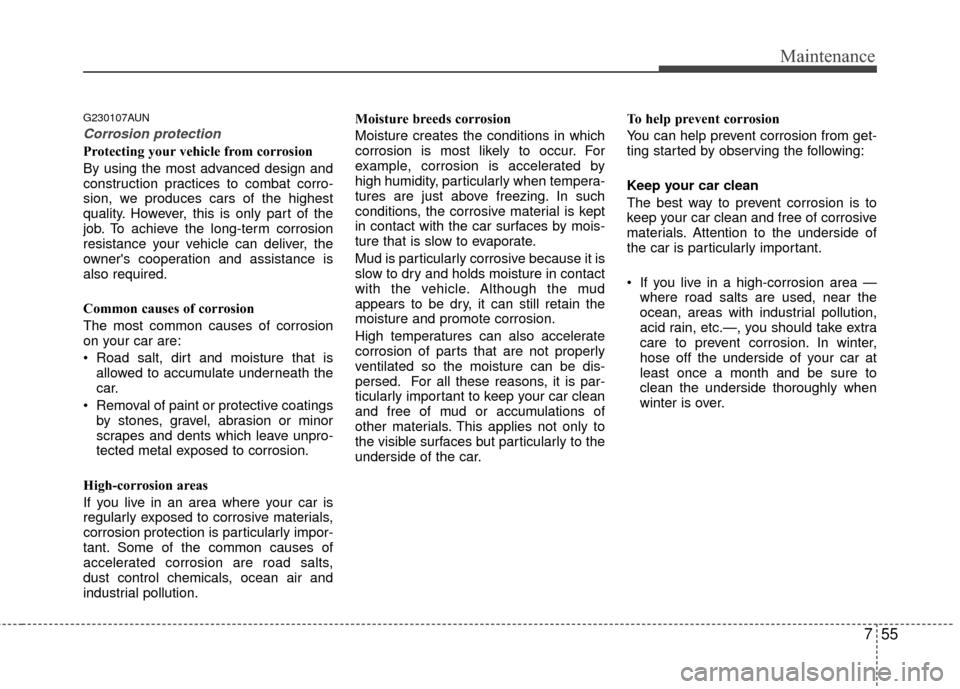
755
Maintenance
G230107AUN
Corrosion protection
Protecting your vehicle from corrosion
By using the most advanced design and
construction practices to combat corro-
sion, we produces cars of the highest
quality. However, this is only part of the
job. To achieve the long-term corrosion
resistance your vehicle can deliver, the
owner's cooperation and assistance is
also required.
Common causes of corrosion
The most common causes of corrosion
on your car are:
allowed to accumulate underneath the
car.
Removal of paint or protective coatings by stones, gravel, abrasion or minor
scrapes and dents which leave unpro-
tected metal exposed to corrosion.
High-corrosion areas
If you live in an area where your car is
regularly exposed to corrosive materials,
corrosion protection is particularly impor-
tant. Some of the common causes of
accelerated corrosion are road salts,
dust control chemicals, ocean air and
industrial pollution. Moisture breeds corrosion
Moisture creates the conditions in which
corrosion is most likely to occur. For
example, corrosion is accelerated by
high humidity, particularly when tempera-
tures are just above freezing. In such
conditions, the corrosive material is kept
in contact with the car surfaces by mois-
ture that is slow to evaporate.
Mud is particularly corrosive because it is
slow to dry and holds moisture in contact
with the vehicle. Although the mud
appears to be dry, it can still retain the
moisture and promote corrosion.
High temperatures can also accelerate
corrosion of parts that are not properly
ventilated so the moisture can be dis-
persed. For all these reasons, it is par-
ticularly important to keep your car clean
and free of mud or accumulations of
other materials. This applies not only to
the visible surfaces but particularly to the
underside of the car.
To help prevent corrosion
You can help prevent corrosion from get-
ting started by observing the following:
Keep your car clean
The best way to prevent corrosion is to
keep your car clean and free of corrosive
materials. Attention to the underside of
the car is particularly important.
If you live in a high-corrosion area —
where road salts are used, near the
ocean, areas with industrial pollution,
acid rain, etc.—, you should take extra
care to prevent corrosion. In winter,
hose off the underside of your car at
least once a month and be sure to
clean the underside thoroughly when
winter is over.